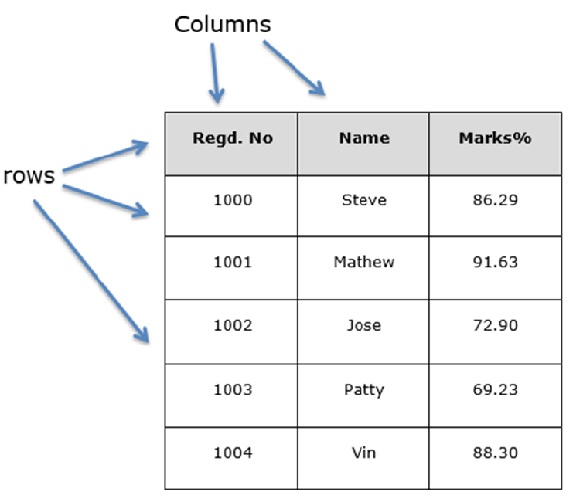
Download our e-book of Introduction To Python
Related Blog
Matplotlib - Subplot2grid() FunctionDiscuss Microsoft Cognitive ToolkitMatplotlib - Working with ImagesMatplotlib - PyLab moduleMatplotlib - Working With TextMatplotlib - Setting Ticks and Tick LabelsCNTK - Creating First Neural NetworkMatplotlib - MultiplotsMatplotlib - Quiver PlotPython - Chunks and Chinks View More
Top Discussion
How can I write Python code to change a date string from "mm/dd/yy hh: mm" format to "YYYY-MM-DD HH: mm" format? Which sorting technique is used by sort() and sorted() functions of python? How to use Enum in python? Can you please help me with this error? I was just selecting some random columns from the diabetes dataset of sklearn. Decision tree is a classification algo...How can it be applied to load diabetes dataset which has DV continuous Objects in Python are mutable or immutable? How can unclassified data in a dataset be effectively managed when utilizing a decision tree-based classification model in Python? How to leave/exit/deactivate a Python virtualenvironment Join Discussion
Top Courses
Webinars
Python Pandas- DataFrame

Vinay Jha
2 years ago

Table of Contents
- Features of DataFrame
- Structure
- Create DataFrame
- pandas.DataFrame
- Create DataFrame
- Create an Empty DataFrame
- Create a DataFrame from Lists
- Create a DataFrame from Dict of ndarrays / Lists
- Create a DataFrame from List of Dicts
- Create a DataFrame from Dict of Series
- Column Selection
- Column Deletion
- Column Addition
- Column Deletion
- Row Selection, Addition, and Deletion
1. Selection by Label
2. Slice Rows
3. Addition of Rows
4. Deletion of Rows
A Data frame is a two-dimensional data structure, i.e., data is aligned in a tabular fashion in rows and columns.
Features of DataFrame
- Potentially columns are of different types
- Size – Mutable
- Labeled axes (rows and columns)
- Can Perform Arithmetic operations on rows and columns
Structure
Let us assume that we are creating a data frame with the student’s structure

You can think of it as an SQL table or a spreadsheet data representation.
pandas.DataFrame
A pandas DataFrame can be created using the following constructor −
pandas.DataFrame( data, index, columns, dtype, copy)
The parameters of the constructor are as follows Table.

Create DataFrame
A pandas DataFrame can be created using various inputs like −
- Lists
- dict
- Series
- Numpy ndarrays
- Another DataFrame
In the subsequent sections of this chapter, we will see how to create a DataFrame using these inputs.
Create an Empty DataFrame
A basic DataFrame, which can be created is an Empty Dataframe.
Example
#import the pandas library and aliasing as pd
import pandas as pd
df = pd.DataFrame()
print dfIts output is as follows −
Empty DataFrame
Columns: []
Index: []
Create a DataFrame from Lists
The DataFrame can be created using a single list or a list of lists.
Example 1
import pandas as pd
data = [1,2,3,4,5]
df = pd.DataFrame(data)
print dfIts output is as follows −
0
0 1
1 2
2 3
3 4
4 5
Example 2
import pandas as pd
data = [['Alex',10],['Bob',12],['Clarke',13]]
df = pd.DataFrame(data,columns=['Name','Age'])
print df
Its output is as follows −
Name Age
0 Alex 10
1 Bob 12
2 Clarke 13
Example 3
import pandas as pd
data = [['Alex',10],['Bob',12],['Clarke',13]]
df = pd.DataFrame(data,columns=['Name','Age'],dtype=float)
print df
Its output is as follows −
Name Age
0 Alex 10.0
1 Bob 12.0
2 Clarke 13.0
Note − Observe, the dtype parameter changes the type of Age column to floating-point.
Create a DataFrame from Dict of ndarrays / Lists
All the ndarrays must be of the same length. If the index is passed, then the length of the index should equal the length of the arrays.
If no index is passed, then by default, index will be range(n), where n is the array length.
Example 1
import pandas as pd
data = {'Name':['Tom', 'Jack', 'Steve', 'Ricky'],'Age':[28,34,29,42]}
df = pd.DataFrame(data)
print dfIts output is as follows −
Age Name
0 28 Tom
1 34 Jack
2 29 Steve
3 42 Ricky
Note − Observe the values 0,1,2,3. They are the default index assigned to each using the function range(n).
Example 2
Let us now create an indexed DataFrame using arrays.
import pandas as pd
data = {'Name':['Tom', 'Jack', 'Steve', 'Ricky'],'Age':[28,34,29,42]}
df = pd.DataFrame(data, index=['rank1','rank2','rank3','rank4'])
print df
Its output is as follows −
Age Name
rank1 28 Tom
rank2 34 Jack
rank3 29 Steve
rank4 42 Ricky
Note − Observe, the index parameter assigns an index to each row.
Create a DataFrame from List of Dicts
List of Dictionaries can be passed as input data to create a DataFrame. The dictionary keys are by default taken as column names.
Example 1
The following example shows how to create a DataFrame by passing a list of dictionaries.
import pandas as pd
data = [{'a': 1, 'b': 2},{'a': 5, 'b': 10, 'c': 20}]
df = pd.DataFrame(data)
print df
Its output is as follows −
a b c
0 1 2 NaN
1 5 10 20.0
Note − Observe, NaN (Not a Number) is appended in missing areas.
Example 2
The following example shows how to create a DataFrame by passing a list of dictionaries and the row indices.
import pandas as pd
data = [{'a': 1, 'b': 2},{'a': 5, 'b': 10, 'c': 20}]
df = pd.DataFrame(data, index=['first', 'second'])
print df
Its output is as follows −
a b c
first 1 2 NaN
second 5 10 20.0
Example 3
The following example shows how to create a DataFrame with a list of dictionaries, row indices, and column indices.
import pandas as pd
data = [{'a': 1, 'b': 2},{'a': 5, 'b': 10, 'c': 20}]
#With two column indices, values same as dictionary keys
df1 = pd.DataFrame(data, index=['first', 'second'], columns=['a', 'b'])
#With two column indices with one index with other name
df2 = pd.DataFrame(data, index=['first', 'second'], columns=['a', 'b1'])
print df1
print df2
Its output is as follows −
#df1 output
a b
first 1 2
second 5 10
#df2 output
a b1
first 1 NaN
second 5 NaN
Note − Observe, df2 DataFrame is created with a column index other than the dictionary key; thus, appended the NaN’s in place. Whereas, df1 is created with column indices the same as dictionary keys, so NaN’s appended.
Create a DataFrame from Dict of Series
Dictionary of Series can be passed to form a DataFrame. The resultant index is the union of all the series indexes passed.
Example
import pandas as pd
d = {'one' : pd.Series([1, 2, 3], index=['a', 'b', 'c']),
'two' : pd.Series([1, 2, 3, 4], index=['a', 'b', 'c', 'd'])}
df = pd.DataFrame(d)
print df
Its output is as follows −
one two
a 1.0 1
b 2.0 2
c 3.0 3
d NaN 4
Note − Observe, for the series one, there is no label ‘d’ passed, but in the result, for the d label, NaN is appended with NaN.
Let us now understand column selection, addition, and deletion through examples.
Column Selection
We will understand this by selecting a column from the DataFrame.
Example
import pandas as pd
d = {'one' : pd.Series([1, 2, 3], index=['a', 'b', 'c']),
'two' : pd.Series([1, 2, 3, 4], index=['a', 'b', 'c', 'd'])}
df = pd.DataFrame(d)
print df ['one']
Its output is as follows −
a 1.0
b 2.0
c 3.0
d NaN
Name: one, dtype: float64
Column Addition
We will understand this by adding a new column to an existing data frame.
Example
import pandas as pd
d = {'one' : pd.Series([1, 2, 3], index=['a', 'b', 'c']),
'two' : pd.Series([1, 2, 3, 4], index=['a', 'b', 'c', 'd'])}
df = pd.DataFrame(d)
# Adding a new column to an existing DataFrame object with column label by passing new series
print ("Adding a new column by passing as Series:")
df['three']=pd.Series([10,20,30],index=['a','b','c'])
print df
print ("Adding a new column using the existing columns in DataFrame:")
df['four']=df['one']+df['three']
print df
Its output is as follows −
Adding a new column by passing as Series:
one two three
a 1.0 1 10.0
b 2.0 2 20.0
c 3.0 3 30.0
d NaN 4 NaN
Adding a new column using the existing columns in DataFrame:
one two three four
a 1.0 1 10.0 11.0
b 2.0 2 20.0 22.0
c 3.0 3 30.0 33.0
d NaN 4 NaN NaN
Column Deletion
Columns can be deleted or popped; let us take an example to understand how.
Example
# Using the previous DataFrame, we will delete a column
# using del function
import pandas as pd
d = {'one' : pd.Series([1, 2, 3], index=['a', 'b', 'c']),
'two' : pd.Series([1, 2, 3, 4], index=['a', 'b', 'c', 'd']),
'three' : pd.Series([10,20,30], index=['a','b','c'])}
df = pd.DataFrame(d)
print ("Our dataframe is:")
print df
# using del function
print ("Deleting the first column using DEL function:")
del df['one']
print df
# using pop function
print ("Deleting another column using POP function:")
df.pop('two')
print df
Its output is as follows −
Our dataframe is:
one three two
a 1.0 10.0 1
b 2.0 20.0 2
c 3.0 30.0 3
d NaN NaN 4
Deleting the first column using DEL function:
three two
a 10.0 1
b 20.0 2
c 30.0 3
d NaN 4
Deleting another column using POP function:
three
a 10.0
b 20.0
c 30.0
d NaN
Row Selection, Addition, and Deletion
We will now understand row selection, addition and deletion through examples. Let us begin with the concept of selection.
Selection by Label
Rows can be selected by passing row labels to a loc function.
import pandas as pd
d = {'one' : pd.Series([1, 2, 3], index=['a', 'b', 'c']),
'two' : pd.Series([1, 2, 3, 4], index=['a', 'b', 'c', 'd'])}
df = pd.DataFrame(d)
print df.loc['b']
Its output is as follows −
one 2.0
two 2.0
Name: b, dtype: float64
The result is a series with labels as column names of the DataFrame. And, the Name of the series is the label with which it is retrieved.
Selection by integer location
Rows can be selected by passing integer location to an iloc function.
import pandas as pd
d = {'one' : pd.Series([1, 2, 3], index=['a', 'b', 'c']),
'two' : pd.Series([1, 2, 3, 4], index=['a', 'b', 'c', 'd'])}
df = pd.DataFrame(d)
print df.iloc[2]
Its output is as follows −
one 3.0
two 3.0
Name: c, dtype: float64
Slice Rows
Multiple rows can be selected using ‘: ’ operator.
import pandas as pd
d = {'one' : pd.Series([1, 2, 3], index=['a', 'b', 'c']),
'two' : pd.Series([1, 2, 3, 4], index=['a', 'b', 'c', 'd'])}
df = pd.DataFrame(d)
print df[2:4]
Its output is as follows −
one two
c 3.0 3
d NaN 4
Addition of Rows
Add new rows to a DataFrame using the append function. This function will append the rows at the end.
import pandas as pd
df = pd.DataFrame([[1, 2], [3, 4]], columns = ['a','b'])
df2 = pd.DataFrame([[5, 6], [7, 8]], columns = ['a','b'])
df = df.append(df2)
print df
Its output is as follows −
a b
0 1 2
1 3 4
0 5 6
1 7 8
Deletion of Rows
Use index label to delete or drop rows from a DataFrame. If label is duplicated, then multiple rows will be dropped.
If you observe, in the above example, the labels are duplicate. Let us drop a label and will see how many rows will get dropped.
import pandas as pd
df = pd.DataFrame([[1, 2], [3, 4]], columns = ['a','b'])
df2 = pd.DataFrame([[5, 6], [7, 8]], columns = ['a','b'])
df = df.append(df2)
# Drop rows with label 0
df = df.drop(0)
print df
Its output is as follows −
a b
1 3 4
1 7 8
In the above example, two rows were dropped because those two contain the same label 0.
Enjoyed reading this blog? Then why not share it with others. Help us make this AI community stronger.
To learn more about such concepts related to Artificial Intelligence, visit our insideAIML blog page.
You can also ask direct queries related to Artificial Intelligence, Deep Learning, Data Science and Machine Learning on our live insideAIML discussion forum.
Keep Learning. Keep Growing.
